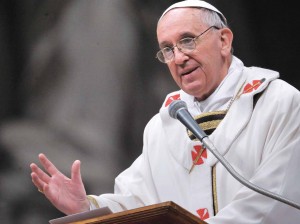Front Row With Francis: How the Family Evangelizes
 What is the best social network for the New Evangelization? Is it Facebook or Twitter? Or perhaps Instagram and Pinterest better reflect our modern lives? Or are you a Snapchat aficionado? Forget it, Pope Francis just rebooted this conversation. At his Wednesday General Audience on October 7, 2015, he revealed his social network of choice for evangelization: the family.
What is the best social network for the New Evangelization? Is it Facebook or Twitter? Or perhaps Instagram and Pinterest better reflect our modern lives? Or are you a Snapchat aficionado? Forget it, Pope Francis just rebooted this conversation. At his Wednesday General Audience on October 7, 2015, he revealed his social network of choice for evangelization: the family.
“When Jesus called Peter to follow him, he told him that he would make him a ‘fisher of men’,” Francis recalled, “and for this, a new type of nets is needed. We could say that today families are one of the most important nets for the mission of Peter and of the Church.”
Walking along the shores of the Sea of Galilee, Jesus runs across the fishermen brothers Simon (Peter) and Andrew, and James and John, fishing in the water. He beckons them, making an offer that promises to radically revolutionize their lives: “Follow me and I will make you fishers of men.” They all accept. (Matt. 4:19-22.)
Two sets of brothers produce the first four vocations of the Church. By initiating his new family (the church) with these pairs, Jesus literally makes brotherhood its cornerstones. The new bonds that will be the building blocks of the fledgling Church will have to live up to this high standard of strength and love. Indeed, we see blood relations fill out the ranks: James and Jude, James the Less and Matthew, and others.
Additionally, the roots of these families dig deep into the society of the Galilee: James and John are well-off, with a boat and servants (that they leave behind). Peter and Andrew have only nets that they wade into the sea to cast into the water. By choosing families, Jesus draws in the pieces of the culture enmeshed in them.
The same dynamics are reflected in the integration of other holy families into the fishing nets of the kingdom. Consider the case of St. Basil the Great and his family.
St. Basil was born around 330 AD in Caesaria (modern day Turkey). Basil was Archbishop of Caesarea and is a Doctor of the Church. Basil’s brother was St. Gregory of Nyssa; both are included in the Cappadocian Fathers. But wait. There’s more.
Basil had three other siblings who are canonized saints: Saint Macrina the Younger (a nun), Saint Naucratius (a monk) and St. Peter of Sebasteia (like Basil and Gregory, a bishop). St. Basil’s father, Basil the Elder—you guessed it—also a saint. (St. Basil’s mother Emmelia is venerated as a saint by the Eastern Orthodox.) St. Basil’s grandmother was a saint, and so was his maternal great-grandfather, who had been fed to the lions and martyred.
Basil always credited his mother and his grandmother for his faith: “I shall never forget the deep impressions made on me as a boy by the words and examples of these venerable women,” he would say.
Basil’s paternal grandmother was Saint Macrina the Elder who had lived through periods of persecution and endured outlaw status during these bitter years. She would tell young Basil about those times, and about St. Gregory Thaumaturgos, the apostle of Pontus and bishop of Neocaeserea, whom she had known. St. Gregory Thaumaturgos had been a disciple of the seminal Christian thinker Origen.
In short, St. Basil’s grandmother was able to net Basil and his family for Christ, and to pass on the traditions of sainthood and martyrdom from their admirable lineage.
So, that blog you have may be clever and all. But if we really want to be fishers of men, we are going to need more nets like the family.

